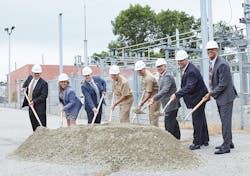Connecticut has released $5 million to establish a microgrid project at the U.S. Naval Submarine Base in Groton.
Announced last week by Gov. Dannel Malloy, the grant comes from the Connecticut Microgrid Program. Now in its fifth year, the program has issued $18.4 million for ten microgrids. Nine are in operation and one is under construction.
Malloy tied the submarine base microgrid to Connecticut’s efforts to withstand storms brought on by climate change.
Durig power outages, the microgrid will provide on-site power for mission critical loads, such as submarines in port. Under normal conditions, the community grid will buy its power.
Long in the making, the microgrid project goes back to 2010 when it was proposed by Connecticut’s Office of Military Affairs. But its technical complexity – and the need for senior Navy endorsement — initially delayed the project. It regained life in 2012 when Gov. Malloy enlisted support from then-Secretary of the Navy Ray Mabus, who sent staff to Connecticut to assist.
In 2015, the State Bond Commission authorized funding to the Navy for early design. Later, the Connecticut Municipal Electric Energy Cooperative entered into a use lease agreement with the Navy for property where 7.4-MW of fuel cells, manufactured by FuelCell Energy, are now being installed as part of the system. The project also will use a 5-MW natural gas combustion turbine and emergency generators. The base expects the full microgrid project to be complete in 2019.
Paul Whitescarver, commanding officer of the base, said that the micogrid project will “enhance our power diversification, our physical and energy security, and most certainly our community collaboration.”
“This proposal promises to enhance the resilience of important national security infrastructure in preparation for climate change, sea level rise, and severe weather events,” Rob Klee, commissioner at Connecticut’s Department of Energy and Environmental Protection. “Our staff will work closely with stakeholders to ensure that the Navy’s energy and resilience objectives are met through the development of a well-planned microgrid project.”
Before 2012’s Superstorm Sandy spurred microgrids in other Northeastern states, Connecticut was already working on them as a result of a storm panel set up by Malloy. DEEP issued competitive solicitations for microgrid project development in 2013 and 2014 and received applications on a rolling basis from 2015 to 2017.
Track news about microgrid project development. Follow Microgrid Knowledge on Twitter @MicrogridNews.







